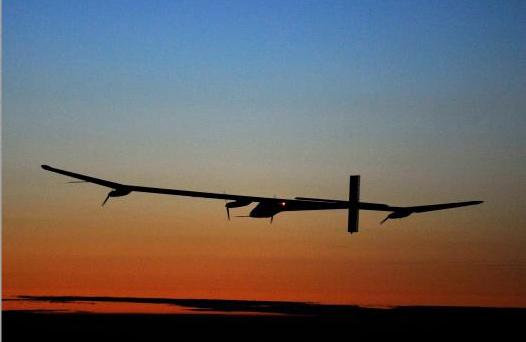Science Fiction
Dictionary
A B C D E F G H I J K L M N O P Q R S T U V W X Y Z
Solar Impulse Completes Night Flight

Solar Impulse, the four-engine solar-powered Swiss plane, completed a 26 hour flight. Pilot Andre Borschberg flew the craft to an altitude of 8,654 meters while achieving a top ground speed of 68 knots.

(Solar Impulse lands after 26 hours)
Solar Impulse's 12,000 solar panels cover its 64 meter wingspan; approximately one-quarter of the weight of the plane is accounted for by the lithium batteries that powered it at night.
The Solar Impulse thus solved a problem with solar-powered aircraft described by far-seeing sf author and editor John W. Campbell in his 1930 novel The Black Star Passes:
"Dad, I believe that you have been trying to develop a successful solar engine. One that could be placed in the wings of a plane to generate power from the light falling on that surface...""...the one big trouble with all solar engines, eliminating the obvious restriction that they decidedly aren't dependable for night work, is the difficulty of getting an area to absorb the energy.
Thanks to Fortigurn for pointing out this story.
Scroll down for more stories in the same category. (Story submitted 7/11/2010)
Follow this kind of news @Technovelgy.| Email | RSS | Blog It | Stumble | del.icio.us | Digg | Reddit |
Would
you like to contribute a story tip?
It's easy:
Get the URL of the story, and the related sf author, and add
it here.
Comment/Join discussion ( 0 )
Related News Stories - (" Engineering ")
The Zapata Air Scooter Would Be Great In A Science Fiction Story
'Betty's slapdash style.'
Could Crystal Batteries Generate Power For Centuries?
'Power could be compressed thus into an inch-square cube of what looked like blue-white ice' - Edmond Hamilton, 1940.
Replace The Smartphone With A Connected Edge Node For AI Inference
'Buy a Little Dingbat... electropen, wrist watch, pocketphone, pocket radio, billfold ... all in one.' - Raymond F. Jones, 1945.
Sunday Robotics 'Memo' Bot Has Unique Training Glove
'He then started hand movements of definite pattern...' - Robert Heinlein, 1942
Technovelgy (that's tech-novel-gee!) is devoted to the creative science inventions and ideas of sf authors. Look for the Invention Category that interests you, the Glossary, the Invention Timeline, or see what's New.
Science Fiction
Timeline
1600-1899
1900-1939
1940's 1950's
1960's 1970's
1980's 1990's
2000's 2010's
Current News
The Zapata Air Scooter Would Be Great In A Science Fiction Story
'Betty's slapdash style.'
Thermostabilized Wet Meat Product (NASA Prototype)
There are no orbiting Michelin stars. Yet.
Could Crystal Batteries Generate Power For Centuries?
'Power could be compressed thus into an inch-square cube of what looked like blue-white ice'
India Ponders Always-On Smartphone Location Tracking
'It is necessary... for your own protection.'
Amazon Will Send You Heinlein's Knockdown Cabin
'It's so light that you can set it up in five minutes by yourself...'
Is It Time To Forbid Human Driving?
'Heavy penalties... were to be applied to any one found driving manually-controlled machines.'
Replace The Smartphone With A Connected Edge Node For AI Inference
'Buy a Little Dingbat... electropen, wrist watch, pocketphone, pocket radio, billfold ... all in one.'
Artificial Skin For Robots Is Coming Right Along
'... an elastic, tinted material that had all the feel and appearance of human flesh and epidermis.'
Robot Guard Dog On Duty
I might also be thinking of K-9 from Doctor Who.
Wearable Artificial Fabric Muscles
'It is remarkable that the long leverages of their machines are in most cases actuated by a sort of sham musculature...'
BrainBridge Concept Transplant Of Human Head Proposed
'Briquet’s head seemed to think that to find and attach a new body to her head was as easy as to fit and sew a new dress.'
Google's Nano Banana Pro Presents Handwritten Math Solutions
'...copy was turned out in a charming and entirely feminine handwriting.'
Edible Meat-Like Fungus Like Barbara Hambly's Slunch?
'It was almost unheard of for slunch to spread that fast...'
Sunday Robotics 'Memo' Bot Has Unique Training Glove
'He then started hand movements of definite pattern...'
Woman Marries Computer, Vonnegut's Dream Comes True
'Men are made of protoplasm... Lasts forever.'
Natural Gait With Prosthetic Connected To Nervous System
'The leg was to function, in a way, as a servo-mechanism operated by Larry’s brain...'
